Analyzing Business Law: Sources, Impact on Business & Resolutions
VerifiedAdded on 2023/06/15
|12
|3742
|135
Report
AI Summary
This report provides a comprehensive overview of business law in the United Kingdom, covering various aspects such as the sources of law (primary and secondary), the role of government in law-making (legislative, executive, and judiciary), and the application of statutory and common law in justice courts. It evaluates the effectiveness of the legal system, illustrates the impact of company, employment, and contract law on businesses with specific examples, and explores the legal formation, management, and funding of different types of business organizations. Furthermore, the report recommends legal solutions for resolving disputes, compares different sources of legal advice and support, and critically evaluates the legal system with relevant examples. It delves into unincorporated and incorporated organizations, including sole proprietorships and partnership firms, and their legal implications.

BUSINESS LAW
Paraphrase This Document
Need a fresh take? Get an instant paraphrase of this document with our AI Paraphraser
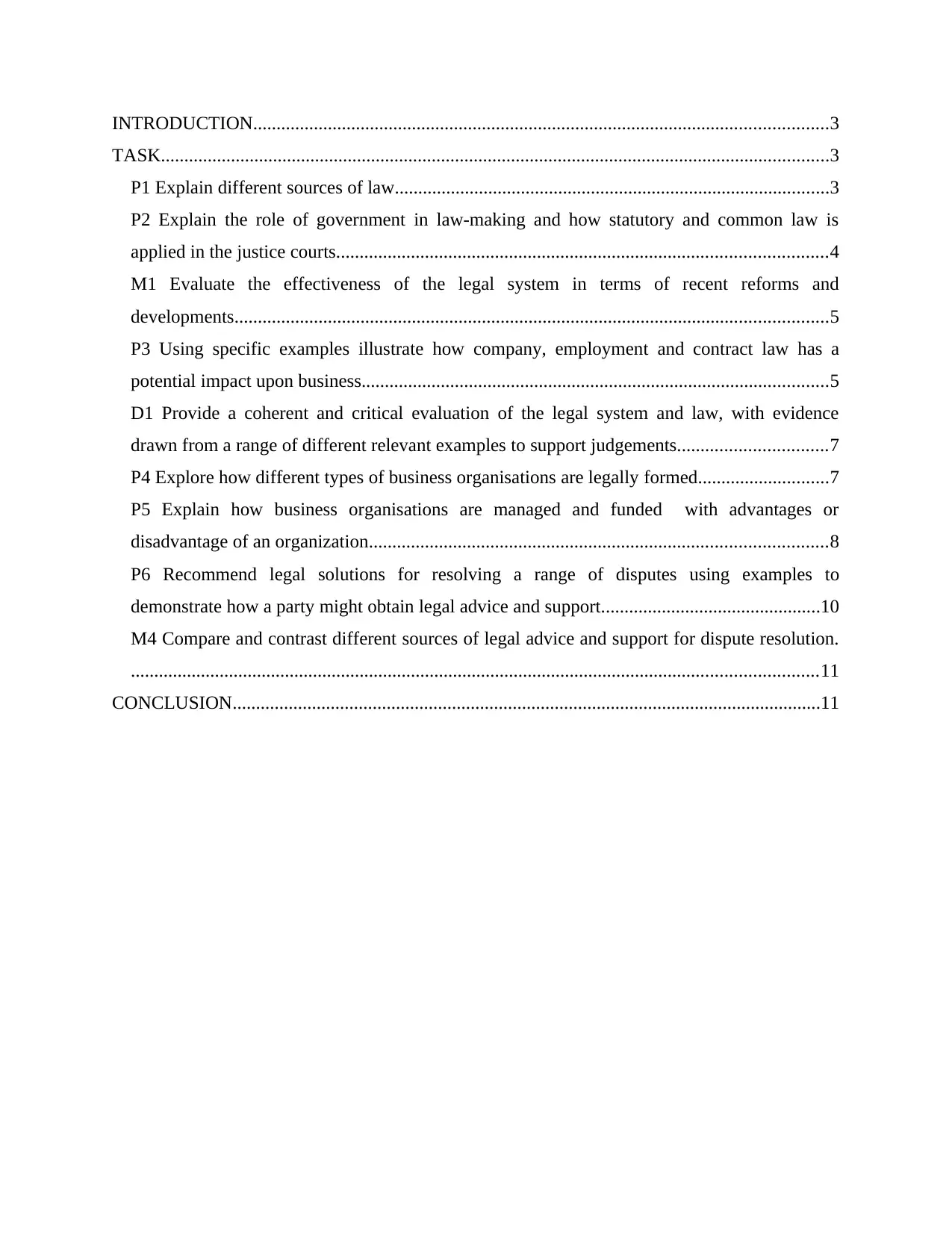
INTRODUCTION...........................................................................................................................3
TASK...............................................................................................................................................3
P1 Explain different sources of law.............................................................................................3
P2 Explain the role of government in law-making and how statutory and common law is
applied in the justice courts.........................................................................................................4
M1 Evaluate the effectiveness of the legal system in terms of recent reforms and
developments...............................................................................................................................5
P3 Using specific examples illustrate how company, employment and contract law has a
potential impact upon business....................................................................................................5
D1 Provide a coherent and critical evaluation of the legal system and law, with evidence
drawn from a range of different relevant examples to support judgements................................7
P4 Explore how different types of business organisations are legally formed............................7
P5 Explain how business organisations are managed and funded with advantages or
disadvantage of an organization..................................................................................................8
P6 Recommend legal solutions for resolving a range of disputes using examples to
demonstrate how a party might obtain legal advice and support...............................................10
M4 Compare and contrast different sources of legal advice and support for dispute resolution.
...................................................................................................................................................11
CONCLUSION..............................................................................................................................11
TASK...............................................................................................................................................3
P1 Explain different sources of law.............................................................................................3
P2 Explain the role of government in law-making and how statutory and common law is
applied in the justice courts.........................................................................................................4
M1 Evaluate the effectiveness of the legal system in terms of recent reforms and
developments...............................................................................................................................5
P3 Using specific examples illustrate how company, employment and contract law has a
potential impact upon business....................................................................................................5
D1 Provide a coherent and critical evaluation of the legal system and law, with evidence
drawn from a range of different relevant examples to support judgements................................7
P4 Explore how different types of business organisations are legally formed............................7
P5 Explain how business organisations are managed and funded with advantages or
disadvantage of an organization..................................................................................................8
P6 Recommend legal solutions for resolving a range of disputes using examples to
demonstrate how a party might obtain legal advice and support...............................................10
M4 Compare and contrast different sources of legal advice and support for dispute resolution.
...................................................................................................................................................11
CONCLUSION..............................................................................................................................11
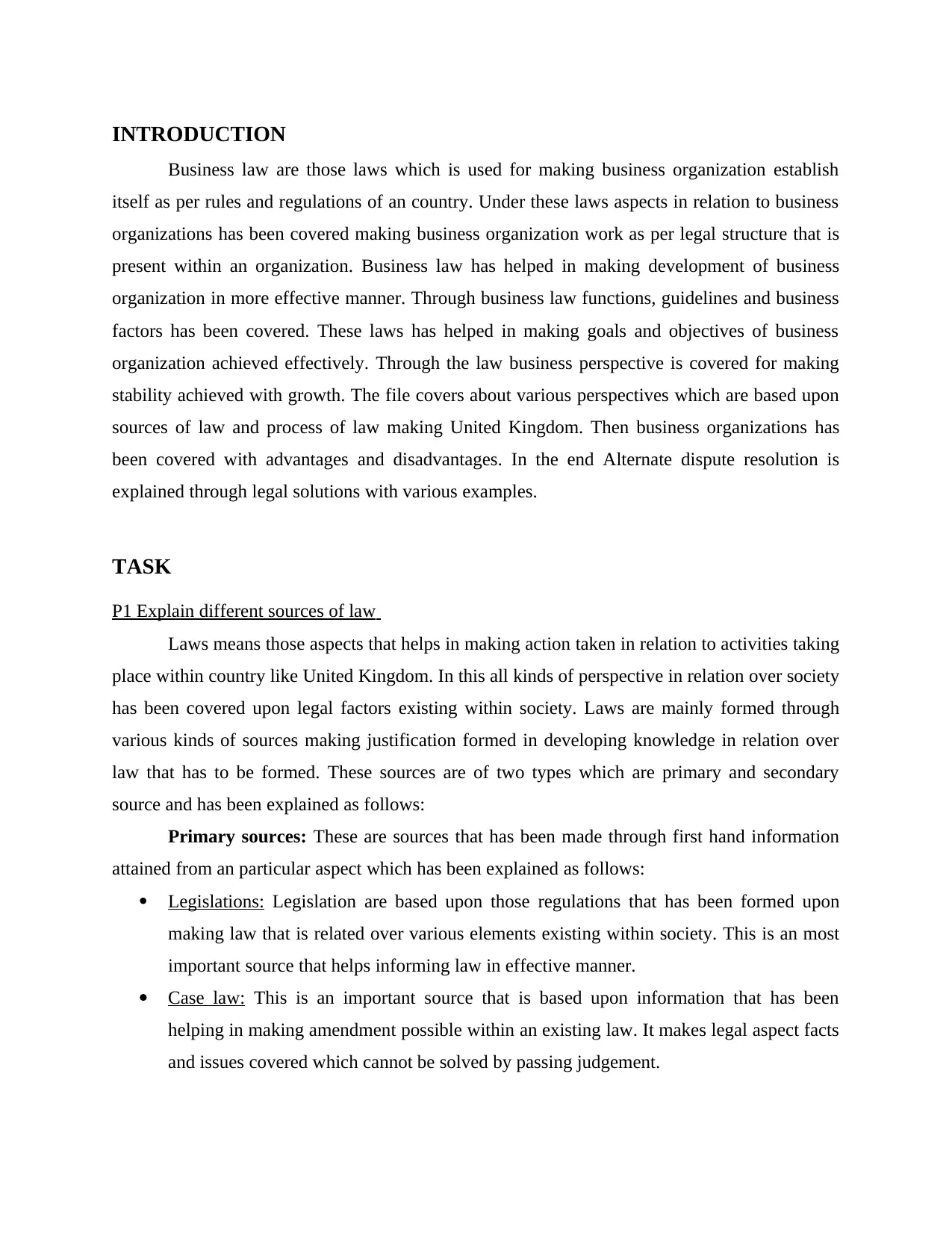
INTRODUCTION
Business law are those laws which is used for making business organization establish
itself as per rules and regulations of an country. Under these laws aspects in relation to business
organizations has been covered making business organization work as per legal structure that is
present within an organization. Business law has helped in making development of business
organization in more effective manner. Through business law functions, guidelines and business
factors has been covered. These laws has helped in making goals and objectives of business
organization achieved effectively. Through the law business perspective is covered for making
stability achieved with growth. The file covers about various perspectives which are based upon
sources of law and process of law making United Kingdom. Then business organizations has
been covered with advantages and disadvantages. In the end Alternate dispute resolution is
explained through legal solutions with various examples.
TASK
P1 Explain different sources of law
Laws means those aspects that helps in making action taken in relation to activities taking
place within country like United Kingdom. In this all kinds of perspective in relation over society
has been covered upon legal factors existing within society. Laws are mainly formed through
various kinds of sources making justification formed in developing knowledge in relation over
law that has to be formed. These sources are of two types which are primary and secondary
source and has been explained as follows:
Primary sources: These are sources that has been made through first hand information
attained from an particular aspect which has been explained as follows:
Legislations: Legislation are based upon those regulations that has been formed upon
making law that is related over various elements existing within society. This is an most
important source that helps informing law in effective manner.
Case law: This is an important source that is based upon information that has been
helping in making amendment possible within an existing law. It makes legal aspect facts
and issues covered which cannot be solved by passing judgement.
Business law are those laws which is used for making business organization establish
itself as per rules and regulations of an country. Under these laws aspects in relation to business
organizations has been covered making business organization work as per legal structure that is
present within an organization. Business law has helped in making development of business
organization in more effective manner. Through business law functions, guidelines and business
factors has been covered. These laws has helped in making goals and objectives of business
organization achieved effectively. Through the law business perspective is covered for making
stability achieved with growth. The file covers about various perspectives which are based upon
sources of law and process of law making United Kingdom. Then business organizations has
been covered with advantages and disadvantages. In the end Alternate dispute resolution is
explained through legal solutions with various examples.
TASK
P1 Explain different sources of law
Laws means those aspects that helps in making action taken in relation to activities taking
place within country like United Kingdom. In this all kinds of perspective in relation over society
has been covered upon legal factors existing within society. Laws are mainly formed through
various kinds of sources making justification formed in developing knowledge in relation over
law that has to be formed. These sources are of two types which are primary and secondary
source and has been explained as follows:
Primary sources: These are sources that has been made through first hand information
attained from an particular aspect which has been explained as follows:
Legislations: Legislation are based upon those regulations that has been formed upon
making law that is related over various elements existing within society. This is an most
important source that helps informing law in effective manner.
Case law: This is an important source that is based upon information that has been
helping in making amendment possible within an existing law. It makes legal aspect facts
and issues covered which cannot be solved by passing judgement.
⊘ This is a preview!⊘
Do you want full access?
Subscribe today to unlock all pages.

Trusted by 1+ million students worldwide
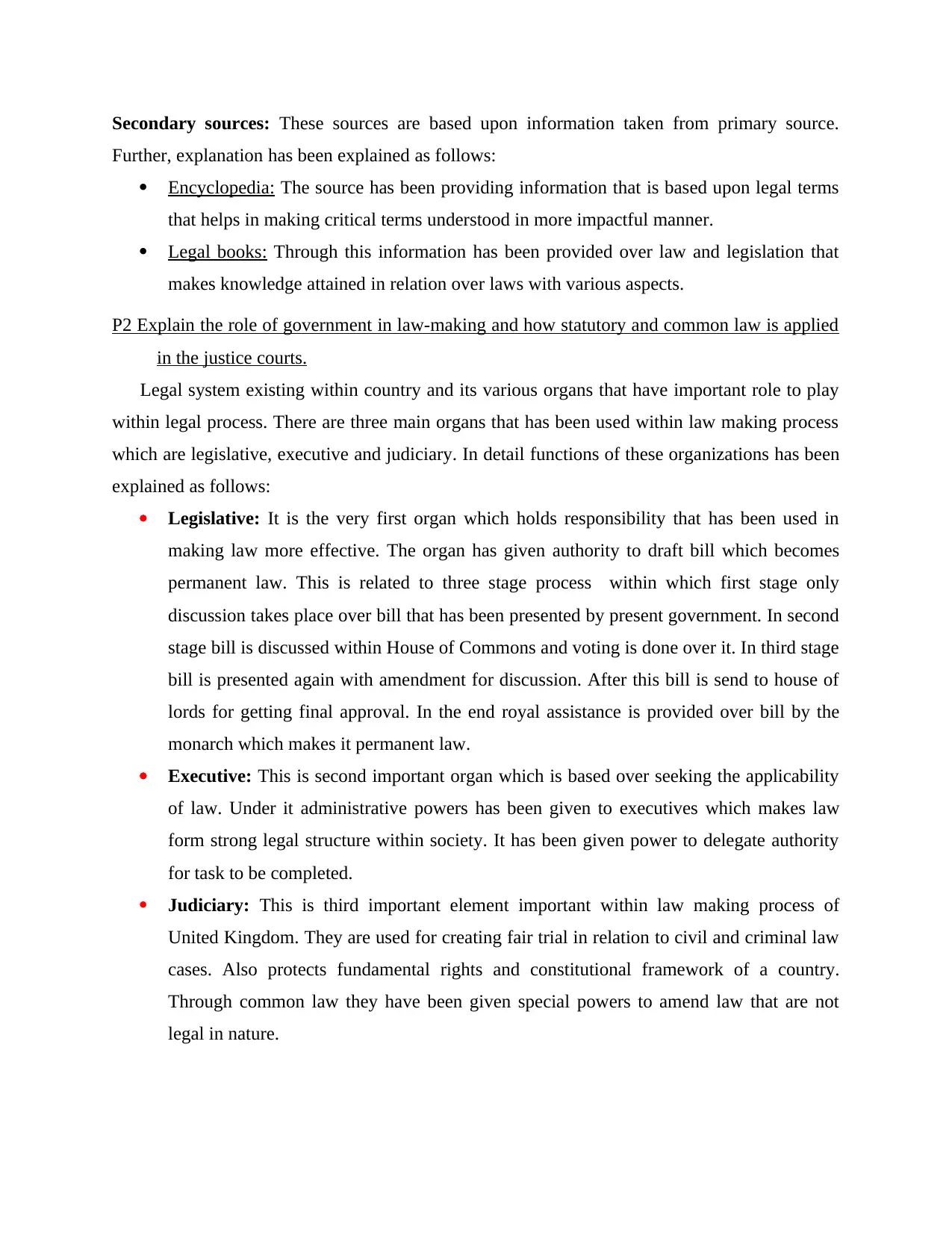
Secondary sources: These sources are based upon information taken from primary source.
Further, explanation has been explained as follows:
Encyclopedia: The source has been providing information that is based upon legal terms
that helps in making critical terms understood in more impactful manner.
Legal books: Through this information has been provided over law and legislation that
makes knowledge attained in relation over laws with various aspects.
P2 Explain the role of government in law-making and how statutory and common law is applied
in the justice courts.
Legal system existing within country and its various organs that have important role to play
within legal process. There are three main organs that has been used within law making process
which are legislative, executive and judiciary. In detail functions of these organizations has been
explained as follows:
Legislative: It is the very first organ which holds responsibility that has been used in
making law more effective. The organ has given authority to draft bill which becomes
permanent law. This is related to three stage process within which first stage only
discussion takes place over bill that has been presented by present government. In second
stage bill is discussed within House of Commons and voting is done over it. In third stage
bill is presented again with amendment for discussion. After this bill is send to house of
lords for getting final approval. In the end royal assistance is provided over bill by the
monarch which makes it permanent law.
Executive: This is second important organ which is based over seeking the applicability
of law. Under it administrative powers has been given to executives which makes law
form strong legal structure within society. It has been given power to delegate authority
for task to be completed.
Judiciary: This is third important element important within law making process of
United Kingdom. They are used for creating fair trial in relation to civil and criminal law
cases. Also protects fundamental rights and constitutional framework of a country.
Through common law they have been given special powers to amend law that are not
legal in nature.
Further, explanation has been explained as follows:
Encyclopedia: The source has been providing information that is based upon legal terms
that helps in making critical terms understood in more impactful manner.
Legal books: Through this information has been provided over law and legislation that
makes knowledge attained in relation over laws with various aspects.
P2 Explain the role of government in law-making and how statutory and common law is applied
in the justice courts.
Legal system existing within country and its various organs that have important role to play
within legal process. There are three main organs that has been used within law making process
which are legislative, executive and judiciary. In detail functions of these organizations has been
explained as follows:
Legislative: It is the very first organ which holds responsibility that has been used in
making law more effective. The organ has given authority to draft bill which becomes
permanent law. This is related to three stage process within which first stage only
discussion takes place over bill that has been presented by present government. In second
stage bill is discussed within House of Commons and voting is done over it. In third stage
bill is presented again with amendment for discussion. After this bill is send to house of
lords for getting final approval. In the end royal assistance is provided over bill by the
monarch which makes it permanent law.
Executive: This is second important organ which is based over seeking the applicability
of law. Under it administrative powers has been given to executives which makes law
form strong legal structure within society. It has been given power to delegate authority
for task to be completed.
Judiciary: This is third important element important within law making process of
United Kingdom. They are used for creating fair trial in relation to civil and criminal law
cases. Also protects fundamental rights and constitutional framework of a country.
Through common law they have been given special powers to amend law that are not
legal in nature.
Paraphrase This Document
Need a fresh take? Get an instant paraphrase of this document with our AI Paraphraser
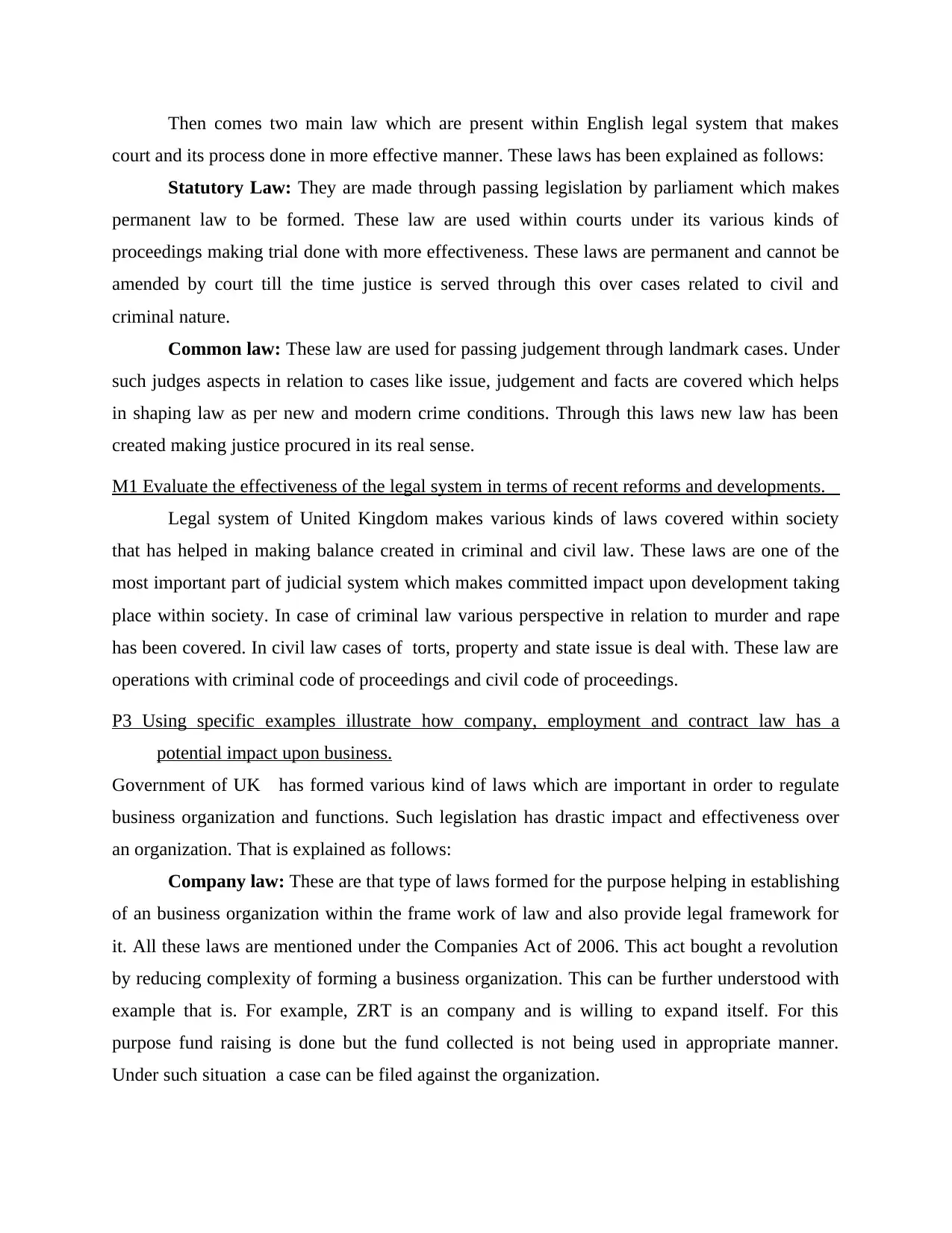
Then comes two main law which are present within English legal system that makes
court and its process done in more effective manner. These laws has been explained as follows:
Statutory Law: They are made through passing legislation by parliament which makes
permanent law to be formed. These law are used within courts under its various kinds of
proceedings making trial done with more effectiveness. These laws are permanent and cannot be
amended by court till the time justice is served through this over cases related to civil and
criminal nature.
Common law: These law are used for passing judgement through landmark cases. Under
such judges aspects in relation to cases like issue, judgement and facts are covered which helps
in shaping law as per new and modern crime conditions. Through this laws new law has been
created making justice procured in its real sense.
M1 Evaluate the effectiveness of the legal system in terms of recent reforms and developments.
Legal system of United Kingdom makes various kinds of laws covered within society
that has helped in making balance created in criminal and civil law. These laws are one of the
most important part of judicial system which makes committed impact upon development taking
place within society. In case of criminal law various perspective in relation to murder and rape
has been covered. In civil law cases of torts, property and state issue is deal with. These law are
operations with criminal code of proceedings and civil code of proceedings.
P3 Using specific examples illustrate how company, employment and contract law has a
potential impact upon business.
Government of UK has formed various kind of laws which are important in order to regulate
business organization and functions. Such legislation has drastic impact and effectiveness over
an organization. That is explained as follows:
Company law: These are that type of laws formed for the purpose helping in establishing
of an business organization within the frame work of law and also provide legal framework for
it. All these laws are mentioned under the Companies Act of 2006. This act bought a revolution
by reducing complexity of forming a business organization. This can be further understood with
example that is. For example, ZRT is an company and is willing to expand itself. For this
purpose fund raising is done but the fund collected is not being used in appropriate manner.
Under such situation a case can be filed against the organization.
court and its process done in more effective manner. These laws has been explained as follows:
Statutory Law: They are made through passing legislation by parliament which makes
permanent law to be formed. These law are used within courts under its various kinds of
proceedings making trial done with more effectiveness. These laws are permanent and cannot be
amended by court till the time justice is served through this over cases related to civil and
criminal nature.
Common law: These law are used for passing judgement through landmark cases. Under
such judges aspects in relation to cases like issue, judgement and facts are covered which helps
in shaping law as per new and modern crime conditions. Through this laws new law has been
created making justice procured in its real sense.
M1 Evaluate the effectiveness of the legal system in terms of recent reforms and developments.
Legal system of United Kingdom makes various kinds of laws covered within society
that has helped in making balance created in criminal and civil law. These laws are one of the
most important part of judicial system which makes committed impact upon development taking
place within society. In case of criminal law various perspective in relation to murder and rape
has been covered. In civil law cases of torts, property and state issue is deal with. These law are
operations with criminal code of proceedings and civil code of proceedings.
P3 Using specific examples illustrate how company, employment and contract law has a
potential impact upon business.
Government of UK has formed various kind of laws which are important in order to regulate
business organization and functions. Such legislation has drastic impact and effectiveness over
an organization. That is explained as follows:
Company law: These are that type of laws formed for the purpose helping in establishing
of an business organization within the frame work of law and also provide legal framework for
it. All these laws are mentioned under the Companies Act of 2006. This act bought a revolution
by reducing complexity of forming a business organization. This can be further understood with
example that is. For example, ZRT is an company and is willing to expand itself. For this
purpose fund raising is done but the fund collected is not being used in appropriate manner.
Under such situation a case can be filed against the organization.
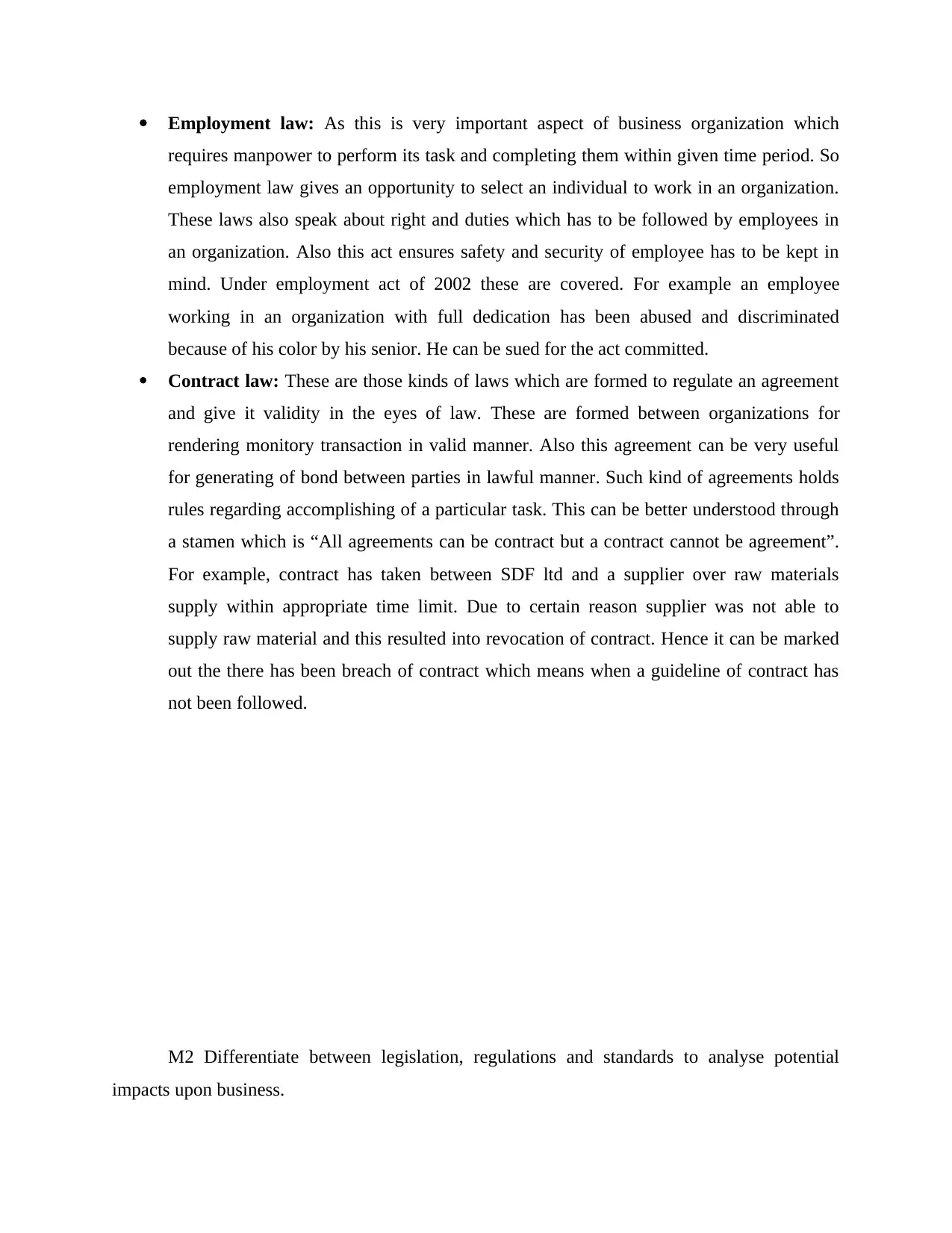
Employment law: As this is very important aspect of business organization which
requires manpower to perform its task and completing them within given time period. So
employment law gives an opportunity to select an individual to work in an organization.
These laws also speak about right and duties which has to be followed by employees in
an organization. Also this act ensures safety and security of employee has to be kept in
mind. Under employment act of 2002 these are covered. For example an employee
working in an organization with full dedication has been abused and discriminated
because of his color by his senior. He can be sued for the act committed.
Contract law: These are those kinds of laws which are formed to regulate an agreement
and give it validity in the eyes of law. These are formed between organizations for
rendering monitory transaction in valid manner. Also this agreement can be very useful
for generating of bond between parties in lawful manner. Such kind of agreements holds
rules regarding accomplishing of a particular task. This can be better understood through
a stamen which is “All agreements can be contract but a contract cannot be agreement”.
For example, contract has taken between SDF ltd and a supplier over raw materials
supply within appropriate time limit. Due to certain reason supplier was not able to
supply raw material and this resulted into revocation of contract. Hence it can be marked
out the there has been breach of contract which means when a guideline of contract has
not been followed.
M2 Differentiate between legislation, regulations and standards to analyse potential
impacts upon business.
requires manpower to perform its task and completing them within given time period. So
employment law gives an opportunity to select an individual to work in an organization.
These laws also speak about right and duties which has to be followed by employees in
an organization. Also this act ensures safety and security of employee has to be kept in
mind. Under employment act of 2002 these are covered. For example an employee
working in an organization with full dedication has been abused and discriminated
because of his color by his senior. He can be sued for the act committed.
Contract law: These are those kinds of laws which are formed to regulate an agreement
and give it validity in the eyes of law. These are formed between organizations for
rendering monitory transaction in valid manner. Also this agreement can be very useful
for generating of bond between parties in lawful manner. Such kind of agreements holds
rules regarding accomplishing of a particular task. This can be better understood through
a stamen which is “All agreements can be contract but a contract cannot be agreement”.
For example, contract has taken between SDF ltd and a supplier over raw materials
supply within appropriate time limit. Due to certain reason supplier was not able to
supply raw material and this resulted into revocation of contract. Hence it can be marked
out the there has been breach of contract which means when a guideline of contract has
not been followed.
M2 Differentiate between legislation, regulations and standards to analyse potential
impacts upon business.
⊘ This is a preview!⊘
Do you want full access?
Subscribe today to unlock all pages.

Trusted by 1+ million students worldwide
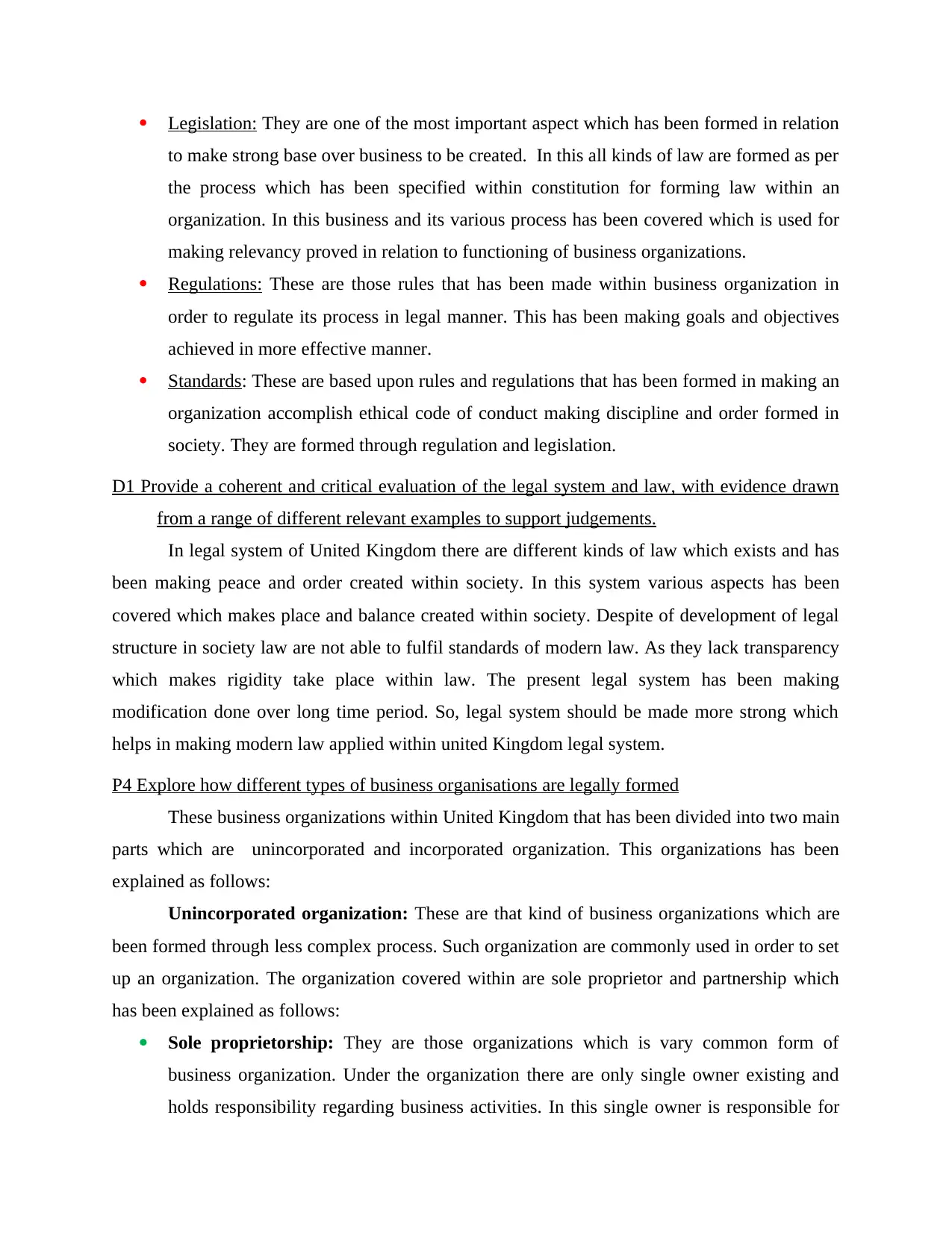
Legislation: They are one of the most important aspect which has been formed in relation
to make strong base over business to be created. In this all kinds of law are formed as per
the process which has been specified within constitution for forming law within an
organization. In this business and its various process has been covered which is used for
making relevancy proved in relation to functioning of business organizations.
Regulations: These are those rules that has been made within business organization in
order to regulate its process in legal manner. This has been making goals and objectives
achieved in more effective manner.
Standards: These are based upon rules and regulations that has been formed in making an
organization accomplish ethical code of conduct making discipline and order formed in
society. They are formed through regulation and legislation.
D1 Provide a coherent and critical evaluation of the legal system and law, with evidence drawn
from a range of different relevant examples to support judgements.
In legal system of United Kingdom there are different kinds of law which exists and has
been making peace and order created within society. In this system various aspects has been
covered which makes place and balance created within society. Despite of development of legal
structure in society law are not able to fulfil standards of modern law. As they lack transparency
which makes rigidity take place within law. The present legal system has been making
modification done over long time period. So, legal system should be made more strong which
helps in making modern law applied within united Kingdom legal system.
P4 Explore how different types of business organisations are legally formed
These business organizations within United Kingdom that has been divided into two main
parts which are unincorporated and incorporated organization. This organizations has been
explained as follows:
Unincorporated organization: These are that kind of business organizations which are
been formed through less complex process. Such organization are commonly used in order to set
up an organization. The organization covered within are sole proprietor and partnership which
has been explained as follows:
Sole proprietorship: They are those organizations which is vary common form of
business organization. Under the organization there are only single owner existing and
holds responsibility regarding business activities. In this single owner is responsible for
to make strong base over business to be created. In this all kinds of law are formed as per
the process which has been specified within constitution for forming law within an
organization. In this business and its various process has been covered which is used for
making relevancy proved in relation to functioning of business organizations.
Regulations: These are those rules that has been made within business organization in
order to regulate its process in legal manner. This has been making goals and objectives
achieved in more effective manner.
Standards: These are based upon rules and regulations that has been formed in making an
organization accomplish ethical code of conduct making discipline and order formed in
society. They are formed through regulation and legislation.
D1 Provide a coherent and critical evaluation of the legal system and law, with evidence drawn
from a range of different relevant examples to support judgements.
In legal system of United Kingdom there are different kinds of law which exists and has
been making peace and order created within society. In this system various aspects has been
covered which makes place and balance created within society. Despite of development of legal
structure in society law are not able to fulfil standards of modern law. As they lack transparency
which makes rigidity take place within law. The present legal system has been making
modification done over long time period. So, legal system should be made more strong which
helps in making modern law applied within united Kingdom legal system.
P4 Explore how different types of business organisations are legally formed
These business organizations within United Kingdom that has been divided into two main
parts which are unincorporated and incorporated organization. This organizations has been
explained as follows:
Unincorporated organization: These are that kind of business organizations which are
been formed through less complex process. Such organization are commonly used in order to set
up an organization. The organization covered within are sole proprietor and partnership which
has been explained as follows:
Sole proprietorship: They are those organizations which is vary common form of
business organization. Under the organization there are only single owner existing and
holds responsibility regarding business activities. In this single owner is responsible for
Paraphrase This Document
Need a fresh take? Get an instant paraphrase of this document with our AI Paraphraser
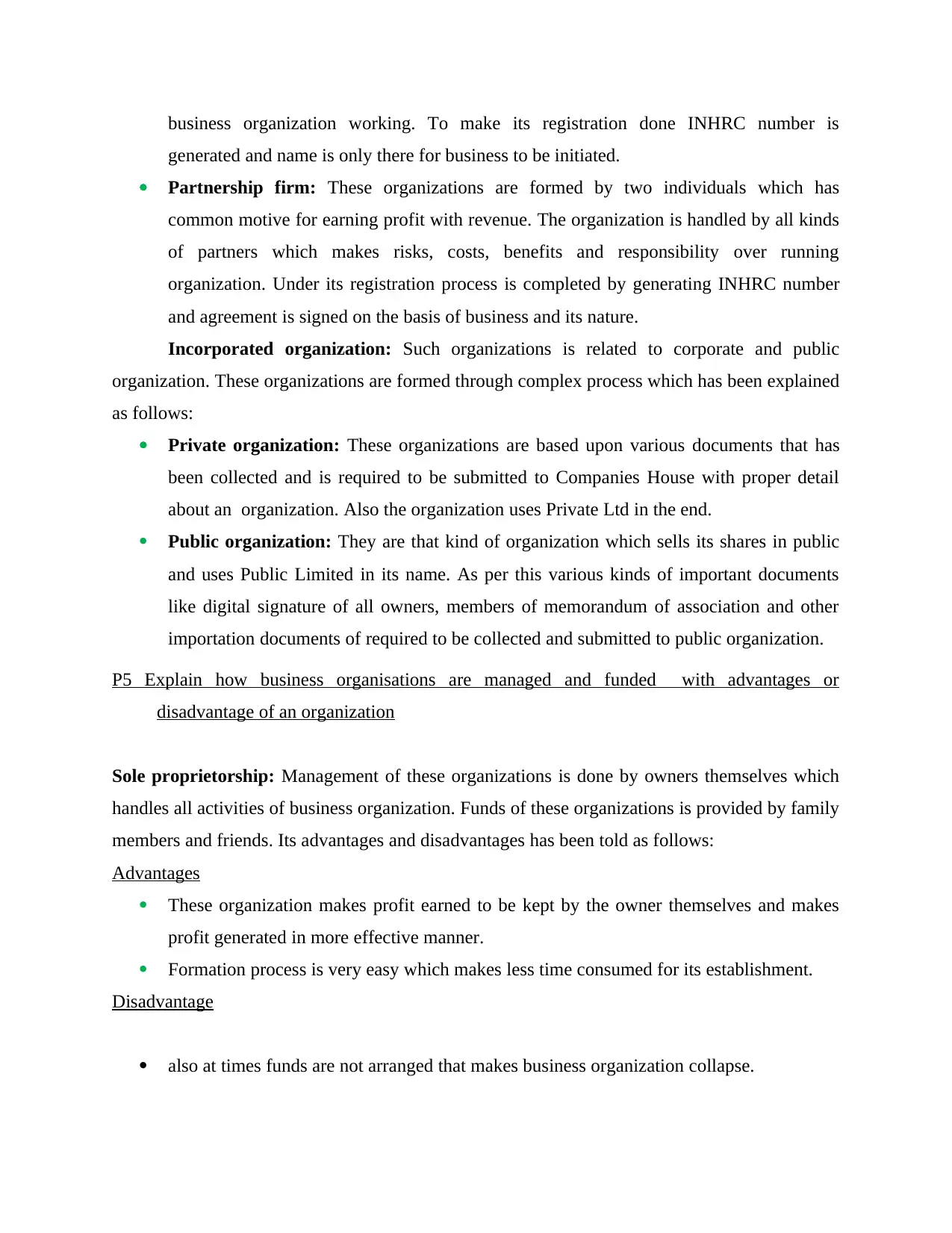
business organization working. To make its registration done INHRC number is
generated and name is only there for business to be initiated.
Partnership firm: These organizations are formed by two individuals which has
common motive for earning profit with revenue. The organization is handled by all kinds
of partners which makes risks, costs, benefits and responsibility over running
organization. Under its registration process is completed by generating INHRC number
and agreement is signed on the basis of business and its nature.
Incorporated organization: Such organizations is related to corporate and public
organization. These organizations are formed through complex process which has been explained
as follows:
Private organization: These organizations are based upon various documents that has
been collected and is required to be submitted to Companies House with proper detail
about an organization. Also the organization uses Private Ltd in the end.
Public organization: They are that kind of organization which sells its shares in public
and uses Public Limited in its name. As per this various kinds of important documents
like digital signature of all owners, members of memorandum of association and other
importation documents of required to be collected and submitted to public organization.
P5 Explain how business organisations are managed and funded with advantages or
disadvantage of an organization
Sole proprietorship: Management of these organizations is done by owners themselves which
handles all activities of business organization. Funds of these organizations is provided by family
members and friends. Its advantages and disadvantages has been told as follows:
Advantages
These organization makes profit earned to be kept by the owner themselves and makes
profit generated in more effective manner.
Formation process is very easy which makes less time consumed for its establishment.
Disadvantage
also at times funds are not arranged that makes business organization collapse.
generated and name is only there for business to be initiated.
Partnership firm: These organizations are formed by two individuals which has
common motive for earning profit with revenue. The organization is handled by all kinds
of partners which makes risks, costs, benefits and responsibility over running
organization. Under its registration process is completed by generating INHRC number
and agreement is signed on the basis of business and its nature.
Incorporated organization: Such organizations is related to corporate and public
organization. These organizations are formed through complex process which has been explained
as follows:
Private organization: These organizations are based upon various documents that has
been collected and is required to be submitted to Companies House with proper detail
about an organization. Also the organization uses Private Ltd in the end.
Public organization: They are that kind of organization which sells its shares in public
and uses Public Limited in its name. As per this various kinds of important documents
like digital signature of all owners, members of memorandum of association and other
importation documents of required to be collected and submitted to public organization.
P5 Explain how business organisations are managed and funded with advantages or
disadvantage of an organization
Sole proprietorship: Management of these organizations is done by owners themselves which
handles all activities of business organization. Funds of these organizations is provided by family
members and friends. Its advantages and disadvantages has been told as follows:
Advantages
These organization makes profit earned to be kept by the owner themselves and makes
profit generated in more effective manner.
Formation process is very easy which makes less time consumed for its establishment.
Disadvantage
also at times funds are not arranged that makes business organization collapse.
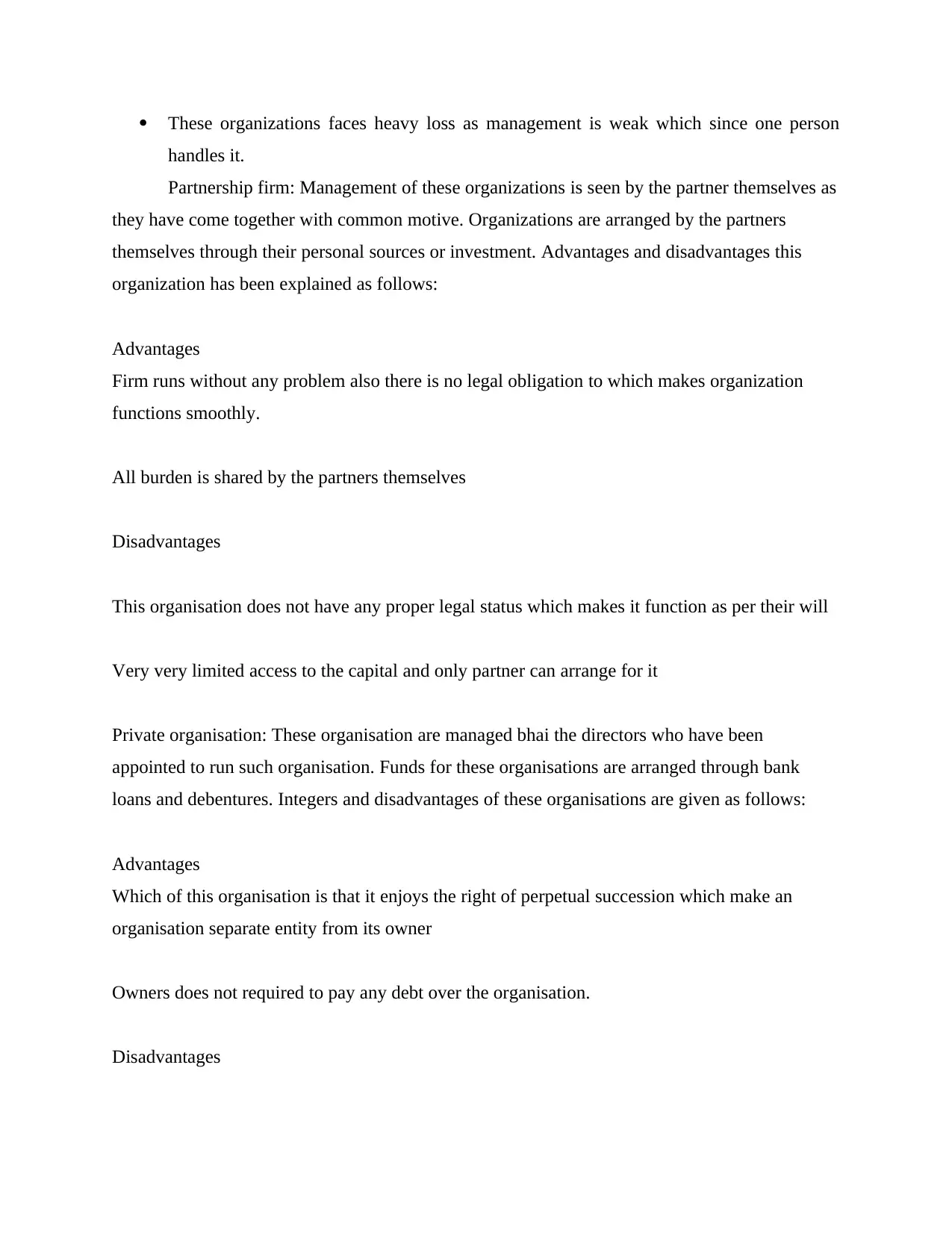
These organizations faces heavy loss as management is weak which since one person
handles it.
Partnership firm: Management of these organizations is seen by the partner themselves as
they have come together with common motive. Organizations are arranged by the partners
themselves through their personal sources or investment. Advantages and disadvantages this
organization has been explained as follows:
Advantages
Firm runs without any problem also there is no legal obligation to which makes organization
functions smoothly.
All burden is shared by the partners themselves
Disadvantages
This organisation does not have any proper legal status which makes it function as per their will
Very very limited access to the capital and only partner can arrange for it
Private organisation: These organisation are managed bhai the directors who have been
appointed to run such organisation. Funds for these organisations are arranged through bank
loans and debentures. Integers and disadvantages of these organisations are given as follows:
Advantages
Which of this organisation is that it enjoys the right of perpetual succession which make an
organisation separate entity from its owner
Owners does not required to pay any debt over the organisation.
Disadvantages
handles it.
Partnership firm: Management of these organizations is seen by the partner themselves as
they have come together with common motive. Organizations are arranged by the partners
themselves through their personal sources or investment. Advantages and disadvantages this
organization has been explained as follows:
Advantages
Firm runs without any problem also there is no legal obligation to which makes organization
functions smoothly.
All burden is shared by the partners themselves
Disadvantages
This organisation does not have any proper legal status which makes it function as per their will
Very very limited access to the capital and only partner can arrange for it
Private organisation: These organisation are managed bhai the directors who have been
appointed to run such organisation. Funds for these organisations are arranged through bank
loans and debentures. Integers and disadvantages of these organisations are given as follows:
Advantages
Which of this organisation is that it enjoys the right of perpetual succession which make an
organisation separate entity from its owner
Owners does not required to pay any debt over the organisation.
Disadvantages
⊘ This is a preview!⊘
Do you want full access?
Subscribe today to unlock all pages.

Trusted by 1+ million students worldwide
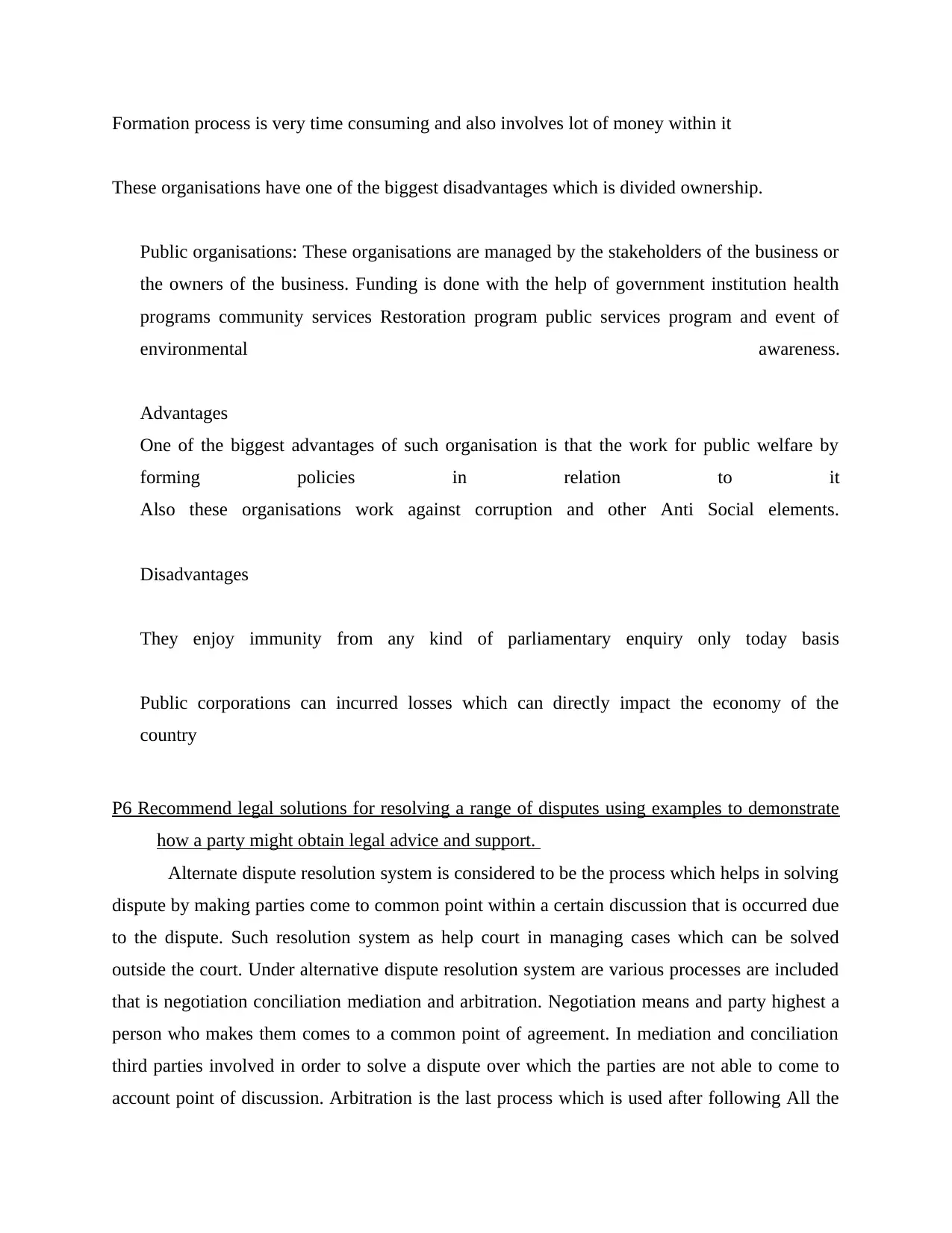
Formation process is very time consuming and also involves lot of money within it
These organisations have one of the biggest disadvantages which is divided ownership.
Public organisations: These organisations are managed by the stakeholders of the business or
the owners of the business. Funding is done with the help of government institution health
programs community services Restoration program public services program and event of
environmental awareness.
Advantages
One of the biggest advantages of such organisation is that the work for public welfare by
forming policies in relation to it
Also these organisations work against corruption and other Anti Social elements.
Disadvantages
They enjoy immunity from any kind of parliamentary enquiry only today basis
Public corporations can incurred losses which can directly impact the economy of the
country
P6 Recommend legal solutions for resolving a range of disputes using examples to demonstrate
how a party might obtain legal advice and support.
Alternate dispute resolution system is considered to be the process which helps in solving
dispute by making parties come to common point within a certain discussion that is occurred due
to the dispute. Such resolution system as help court in managing cases which can be solved
outside the court. Under alternative dispute resolution system are various processes are included
that is negotiation conciliation mediation and arbitration. Negotiation means and party highest a
person who makes them comes to a common point of agreement. In mediation and conciliation
third parties involved in order to solve a dispute over which the parties are not able to come to
account point of discussion. Arbitration is the last process which is used after following All the
These organisations have one of the biggest disadvantages which is divided ownership.
Public organisations: These organisations are managed by the stakeholders of the business or
the owners of the business. Funding is done with the help of government institution health
programs community services Restoration program public services program and event of
environmental awareness.
Advantages
One of the biggest advantages of such organisation is that the work for public welfare by
forming policies in relation to it
Also these organisations work against corruption and other Anti Social elements.
Disadvantages
They enjoy immunity from any kind of parliamentary enquiry only today basis
Public corporations can incurred losses which can directly impact the economy of the
country
P6 Recommend legal solutions for resolving a range of disputes using examples to demonstrate
how a party might obtain legal advice and support.
Alternate dispute resolution system is considered to be the process which helps in solving
dispute by making parties come to common point within a certain discussion that is occurred due
to the dispute. Such resolution system as help court in managing cases which can be solved
outside the court. Under alternative dispute resolution system are various processes are included
that is negotiation conciliation mediation and arbitration. Negotiation means and party highest a
person who makes them comes to a common point of agreement. In mediation and conciliation
third parties involved in order to solve a dispute over which the parties are not able to come to
account point of discussion. Arbitration is the last process which is used after following All the
Paraphrase This Document
Need a fresh take? Get an instant paraphrase of this document with our AI Paraphraser
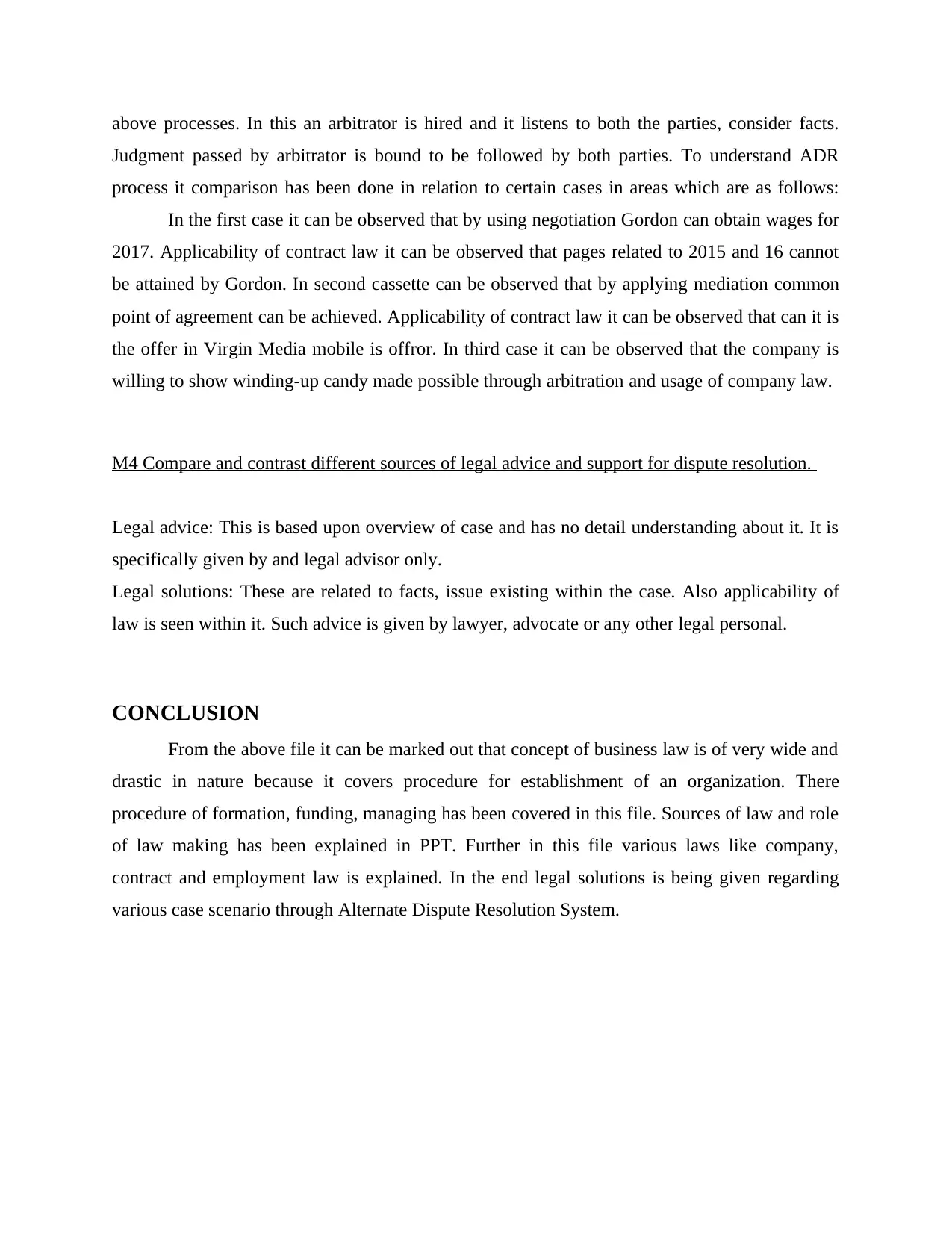
above processes. In this an arbitrator is hired and it listens to both the parties, consider facts.
Judgment passed by arbitrator is bound to be followed by both parties. To understand ADR
process it comparison has been done in relation to certain cases in areas which are as follows:
In the first case it can be observed that by using negotiation Gordon can obtain wages for
2017. Applicability of contract law it can be observed that pages related to 2015 and 16 cannot
be attained by Gordon. In second cassette can be observed that by applying mediation common
point of agreement can be achieved. Applicability of contract law it can be observed that can it is
the offer in Virgin Media mobile is offror. In third case it can be observed that the company is
willing to show winding-up candy made possible through arbitration and usage of company law.
M4 Compare and contrast different sources of legal advice and support for dispute resolution.
Legal advice: This is based upon overview of case and has no detail understanding about it. It is
specifically given by and legal advisor only.
Legal solutions: These are related to facts, issue existing within the case. Also applicability of
law is seen within it. Such advice is given by lawyer, advocate or any other legal personal.
CONCLUSION
From the above file it can be marked out that concept of business law is of very wide and
drastic in nature because it covers procedure for establishment of an organization. There
procedure of formation, funding, managing has been covered in this file. Sources of law and role
of law making has been explained in PPT. Further in this file various laws like company,
contract and employment law is explained. In the end legal solutions is being given regarding
various case scenario through Alternate Dispute Resolution System.
Judgment passed by arbitrator is bound to be followed by both parties. To understand ADR
process it comparison has been done in relation to certain cases in areas which are as follows:
In the first case it can be observed that by using negotiation Gordon can obtain wages for
2017. Applicability of contract law it can be observed that pages related to 2015 and 16 cannot
be attained by Gordon. In second cassette can be observed that by applying mediation common
point of agreement can be achieved. Applicability of contract law it can be observed that can it is
the offer in Virgin Media mobile is offror. In third case it can be observed that the company is
willing to show winding-up candy made possible through arbitration and usage of company law.
M4 Compare and contrast different sources of legal advice and support for dispute resolution.
Legal advice: This is based upon overview of case and has no detail understanding about it. It is
specifically given by and legal advisor only.
Legal solutions: These are related to facts, issue existing within the case. Also applicability of
law is seen within it. Such advice is given by lawyer, advocate or any other legal personal.
CONCLUSION
From the above file it can be marked out that concept of business law is of very wide and
drastic in nature because it covers procedure for establishment of an organization. There
procedure of formation, funding, managing has been covered in this file. Sources of law and role
of law making has been explained in PPT. Further in this file various laws like company,
contract and employment law is explained. In the end legal solutions is being given regarding
various case scenario through Alternate Dispute Resolution System.
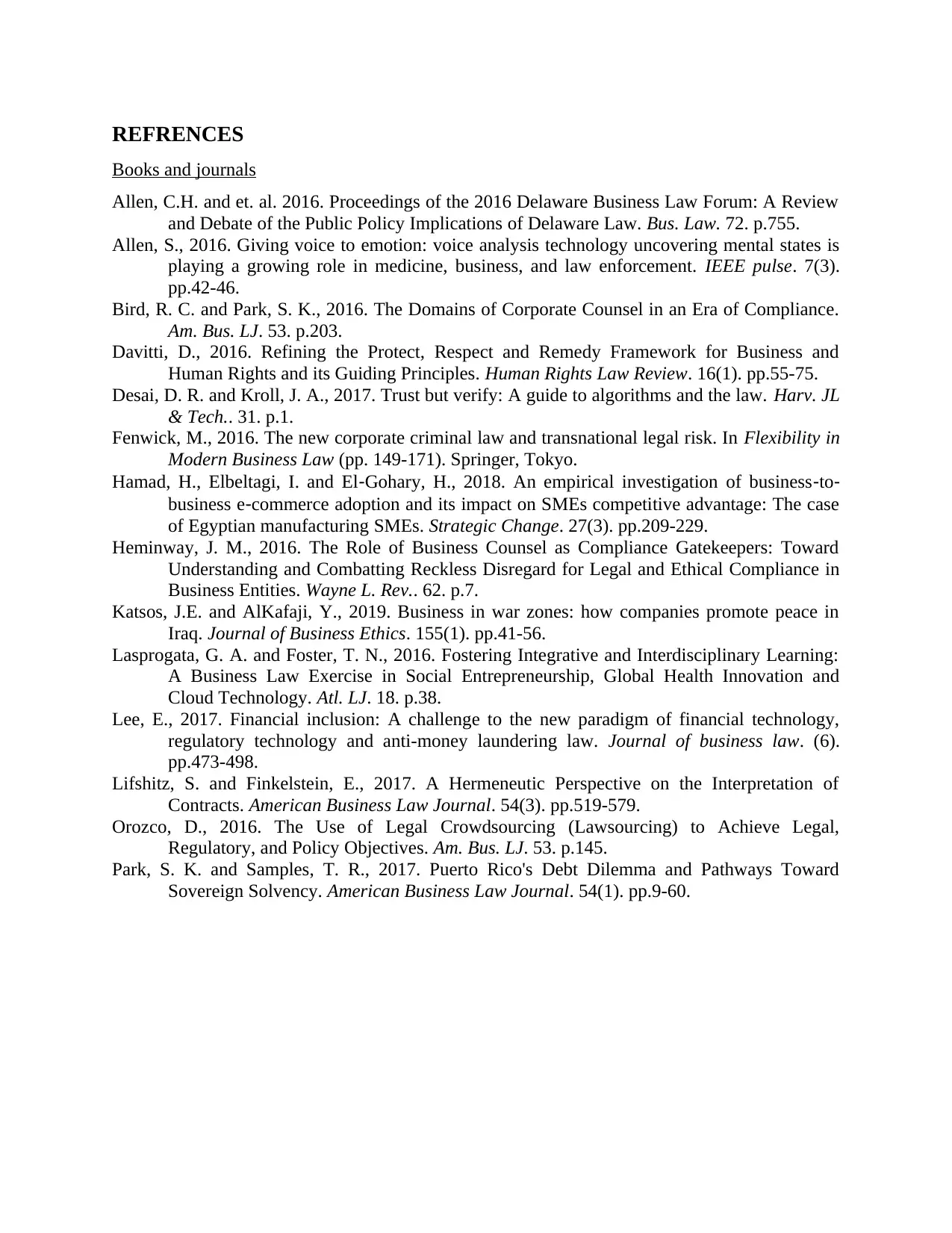
REFRENCES
Books and journals
Allen, C.H. and et. al. 2016. Proceedings of the 2016 Delaware Business Law Forum: A Review
and Debate of the Public Policy Implications of Delaware Law. Bus. Law. 72. p.755.
Allen, S., 2016. Giving voice to emotion: voice analysis technology uncovering mental states is
playing a growing role in medicine, business, and law enforcement. IEEE pulse. 7(3).
pp.42-46.
Bird, R. C. and Park, S. K., 2016. The Domains of Corporate Counsel in an Era of Compliance.
Am. Bus. LJ. 53. p.203.
Davitti, D., 2016. Refining the Protect, Respect and Remedy Framework for Business and
Human Rights and its Guiding Principles. Human Rights Law Review. 16(1). pp.55-75.
Desai, D. R. and Kroll, J. A., 2017. Trust but verify: A guide to algorithms and the law. Harv. JL
& Tech.. 31. p.1.
Fenwick, M., 2016. The new corporate criminal law and transnational legal risk. In Flexibility in
Modern Business Law (pp. 149-171). Springer, Tokyo.
Hamad, H., Elbeltagi, I. and El‐Gohary, H., 2018. An empirical investigation of business‐to‐
business e‐commerce adoption and its impact on SMEs competitive advantage: The case
of Egyptian manufacturing SMEs. Strategic Change. 27(3). pp.209-229.
Heminway, J. M., 2016. The Role of Business Counsel as Compliance Gatekeepers: Toward
Understanding and Combatting Reckless Disregard for Legal and Ethical Compliance in
Business Entities. Wayne L. Rev.. 62. p.7.
Katsos, J.E. and AlKafaji, Y., 2019. Business in war zones: how companies promote peace in
Iraq. Journal of Business Ethics. 155(1). pp.41-56.
Lasprogata, G. A. and Foster, T. N., 2016. Fostering Integrative and Interdisciplinary Learning:
A Business Law Exercise in Social Entrepreneurship, Global Health Innovation and
Cloud Technology. Atl. LJ. 18. p.38.
Lee, E., 2017. Financial inclusion: A challenge to the new paradigm of financial technology,
regulatory technology and anti-money laundering law. Journal of business law. (6).
pp.473-498.
Lifshitz, S. and Finkelstein, E., 2017. A Hermeneutic Perspective on the Interpretation of
Contracts. American Business Law Journal. 54(3). pp.519-579.
Orozco, D., 2016. The Use of Legal Crowdsourcing (Lawsourcing) to Achieve Legal,
Regulatory, and Policy Objectives. Am. Bus. LJ. 53. p.145.
Park, S. K. and Samples, T. R., 2017. Puerto Rico's Debt Dilemma and Pathways Toward
Sovereign Solvency. American Business Law Journal. 54(1). pp.9-60.
Books and journals
Allen, C.H. and et. al. 2016. Proceedings of the 2016 Delaware Business Law Forum: A Review
and Debate of the Public Policy Implications of Delaware Law. Bus. Law. 72. p.755.
Allen, S., 2016. Giving voice to emotion: voice analysis technology uncovering mental states is
playing a growing role in medicine, business, and law enforcement. IEEE pulse. 7(3).
pp.42-46.
Bird, R. C. and Park, S. K., 2016. The Domains of Corporate Counsel in an Era of Compliance.
Am. Bus. LJ. 53. p.203.
Davitti, D., 2016. Refining the Protect, Respect and Remedy Framework for Business and
Human Rights and its Guiding Principles. Human Rights Law Review. 16(1). pp.55-75.
Desai, D. R. and Kroll, J. A., 2017. Trust but verify: A guide to algorithms and the law. Harv. JL
& Tech.. 31. p.1.
Fenwick, M., 2016. The new corporate criminal law and transnational legal risk. In Flexibility in
Modern Business Law (pp. 149-171). Springer, Tokyo.
Hamad, H., Elbeltagi, I. and El‐Gohary, H., 2018. An empirical investigation of business‐to‐
business e‐commerce adoption and its impact on SMEs competitive advantage: The case
of Egyptian manufacturing SMEs. Strategic Change. 27(3). pp.209-229.
Heminway, J. M., 2016. The Role of Business Counsel as Compliance Gatekeepers: Toward
Understanding and Combatting Reckless Disregard for Legal and Ethical Compliance in
Business Entities. Wayne L. Rev.. 62. p.7.
Katsos, J.E. and AlKafaji, Y., 2019. Business in war zones: how companies promote peace in
Iraq. Journal of Business Ethics. 155(1). pp.41-56.
Lasprogata, G. A. and Foster, T. N., 2016. Fostering Integrative and Interdisciplinary Learning:
A Business Law Exercise in Social Entrepreneurship, Global Health Innovation and
Cloud Technology. Atl. LJ. 18. p.38.
Lee, E., 2017. Financial inclusion: A challenge to the new paradigm of financial technology,
regulatory technology and anti-money laundering law. Journal of business law. (6).
pp.473-498.
Lifshitz, S. and Finkelstein, E., 2017. A Hermeneutic Perspective on the Interpretation of
Contracts. American Business Law Journal. 54(3). pp.519-579.
Orozco, D., 2016. The Use of Legal Crowdsourcing (Lawsourcing) to Achieve Legal,
Regulatory, and Policy Objectives. Am. Bus. LJ. 53. p.145.
Park, S. K. and Samples, T. R., 2017. Puerto Rico's Debt Dilemma and Pathways Toward
Sovereign Solvency. American Business Law Journal. 54(1). pp.9-60.
⊘ This is a preview!⊘
Do you want full access?
Subscribe today to unlock all pages.

Trusted by 1+ million students worldwide
1 out of 12
Related Documents
Your All-in-One AI-Powered Toolkit for Academic Success.
+13062052269
info@desklib.com
Available 24*7 on WhatsApp / Email
![[object Object]](/_next/static/media/star-bottom.7253800d.svg)
Unlock your academic potential
Copyright © 2020–2025 A2Z Services. All Rights Reserved. Developed and managed by ZUCOL.




